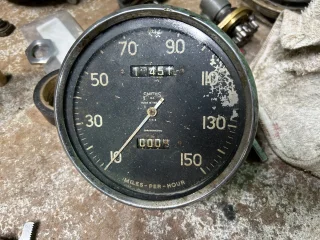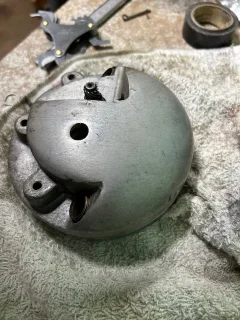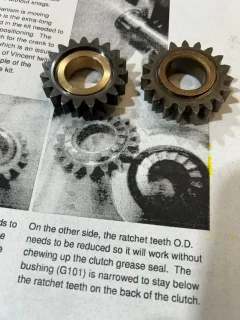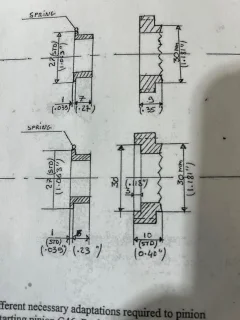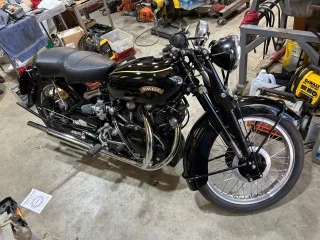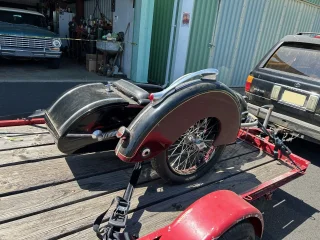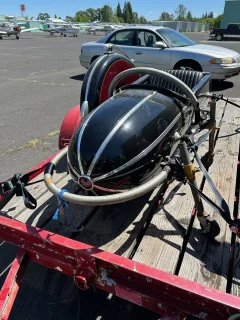I received the following from Francois Grosset:
---------- Forwarded message ---------
From:
Grosset, pont ricoul <
pontricoul@aol.com>
Date: Tue, Apr 23, 2024 at 11:02 PM
Subject: Re: Vincent Electric Start G46 question
To: 998 cc <
rt998cc@gmail.com>
Hi Russ,
The modified G46 is fine most of the time .
Your gearbox final drive shaft or its lengh if not original part, is probably slightly shimmed to the right side of the crankcases which explains this trouble .
have a dry test with no spring cup fitted, it will tell you how much space is missing .
Grinding the ears of this cup should be enough to allow space to have the rachet to work.
If not , you will have to play with the spring itself .
IF you do not have it, below he updated extra instructions /recommandations.
I hope this answer will help , kind regards, francois .
Ideally, have the opportunity to check your gearbox, why not replace the bronze bushes , shimm properly etc ...
This will allow to have your final drive shaft out (the short one that carry the chain sprocket ) .If so , fit this shaft in a lathe chuck + an old gearbox final drive bearing (or a piece of tube the same width) , the final drive chain sprocket, its big nut fully tightened , and remove a bit of material out of the final drive end , ideally say 2 mm .
This will ease you to the have (step 5) the G46AS kick start pinion rachet to work properly in the 'clutch stage', ie when the kickstart crank returns to its top stop position; The oil seal lip is sometimes protruding a bit too far out, best to machine the kickstart pinion ratchet down a bit more than 30mm , say 29. 8 mm od can avoid the lip to interfere with the ratchet teeth.
you MUST NOT need to help the kickstart crank to return to top with your hand; this rachet must be free as originally but .... you have to manage with the space !
Then , always have a fully charged GOOD battery ( YUASA YTX14 H BS, NO cheaper copies) , well setted engine ect .....
I tested many batteries and still recommend the YUASA YTX14 H BS which is 240CCA instead of ytx14bs(200CCA),both are exactly the same size but Hbs one gives 40CCA more power during the electric starter stage. Lithium ones are smaller, lighter, more expensive, interesting to fit to special sporting bikes but plan to have bigger heavy battery wires made if its length is increased, 14mm2 diameter or more..
There is no problem at all with the electric starter fitted to a well setted bike and normal use. This system was designed for very std vincent engine 25 + years ago, however many are fitted to high compression, bigger bore and stroke, it works fine with a perfectly tuned engine that starts first spark with just a kiss on the starter button. Be aware of your ignition system, more settings attention is required when twin plugs are fitted (ask about this matter if necessary), DO NOT have a manual advance, a day or another you will forget to push your ad lever to retard when having to restart after an engine stall at traffic light with a car queue at your back, or this... or that = expensive £,$,€ssss reductor gear teeth repair. Ideally, have a well setted mechanical ATD, reliable system which is not sensible to heat, voltage or amps variations. Good original magneto, points or electronic ignition having mechanical atd is the perfect choice. My ignition system- electronic spark with ATD integrated into a special body- matches perfectly with single or twins electric start equipped or not. Ask for information if needed. A few bikes having modern magneto reported having troubles, mainly when connected for twin sparks, be aware of it.
To start the engine , don't pull the throttle (this is not a jap'nese), keep(adjust) the idle speed quite high to NEVER have the engine to stall because this causes the engine to turn backwards -same as backfire etc....etc .....you need to avoid all this to save disappointment and expensive repair. Actual fuels tend to plug the carb jets when the bike stays unused for too long. CHECK well and clean your pilot jets if your engine does not iddle perfectly, BE sure of throttle cables synchronisation.
You will notice that the bike is difficult to push backward when a gear is engaged, select neutral that is supposed to be available into your gearbox to disengage gear. Of course you need to have a good clutch that does its job properly. Rearward block-up is much appreciated by riders at stop on hills and is not a cause of shear pin breakage.
Common problems caused by:
Weak or dead battery. Have the bike headlight ON and push the button, if it does not turn the engine as before, your battery is gone.
Clogged iddle jet(s), mainly during spring restart. Don't lift the throttle stops, don't pull the twistgrip to compensate it but have your carbs cleaned.
Sump level too high, if you do it sometimes in your kitchen, you should have noticed that is becomes more difficult to pull the string of your salad spinner after a few string pull when the water centrifuged out of the salad is down in the can (sump!) bottom, it does the same if your crankases level is too high: the flywheels are oil flooded and the starter motor gets the overload , so drain the sump and have a go.
If low revs cranks: could be frictions : in the gearbox, primary drive, clutch drum, sprag clutch rubbing the G66AS or inner G1 cover etc .....
The Engine Shock Absorber and a worned chain blade can be a source of trouble.
This sort of
battery disconnector device can be useful for winter rests or to quickly stop an electric problem.
Some of this starter kit are still operating from original having done up to + 100 000 kms with their original shear pin, and they are over 20 years old, so the bikes they are on are performing properly for that to happen. That`s all it takes. So if you have a duff bike, you`ll soon have a duff starter !
Feel free to come back
TO ME if needed instead of reading some posts and answers on the internet, I have been forwarded some of it that contained funny replies and crazy advices from, for sure people who did not understand this 'starter area', forget that way please.
Then ride your Vincent and ENJOY .
François .
May be you already viewed these below , that's the way it should start , the eglis in the older video are hot engines perfectly tuned and are fitted with my electronic ignition .
Traditional way , Ile de Man 2003 : i am the one who finally kick start:
, i fitted a starter since !
last century , before 2000 using a basic video :
: no valve lifter ,all of these bikes with my ignition
19 mai 2020 :
: no valve lifter
Reg Bolton racer :
using valve lifter
Vincent Rapide 1000 twin, tech talk and ride out with fly past :
Another Vincent motorcycle back on the road again:
The way to 1st start a rebuilt or new built engine:
New Vincent HRD engine build and first start up
Hello Francois.
This is Russ Williams in the United States. I am installing your electric start system on a 1951 Vincent Rapide. The kit came supplied with a modified G46 ratchet pinion that was supplied with the recess on the spring side. I assumed it was machined to fit without modification and installed it; however, when assembled, the ratchet is locked and will not allow the kick start lever to return to its resting position. This modified G46 measures about .500" instead of the .400" shown in the instructions. Does it need to be ground down to .400"? This will remove the recess for the spring.
In the attached photo, the G46 from the starter kit is on the left.
Thank you.
Russ Williams
California


